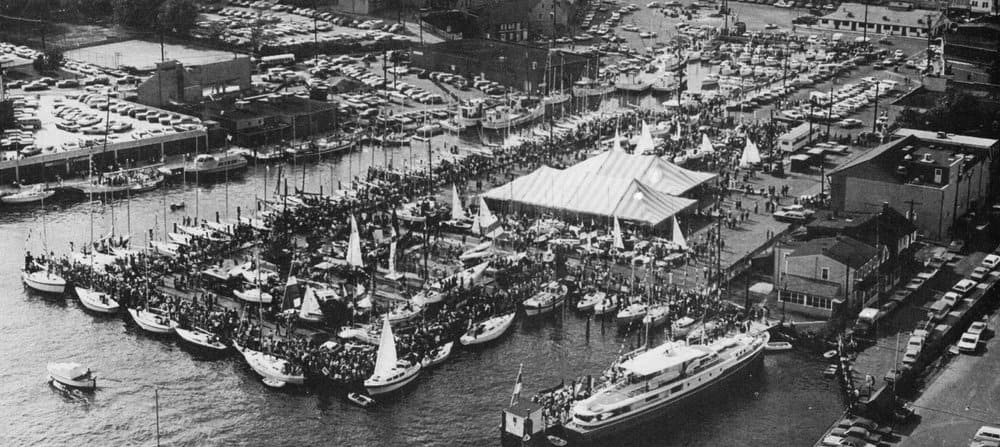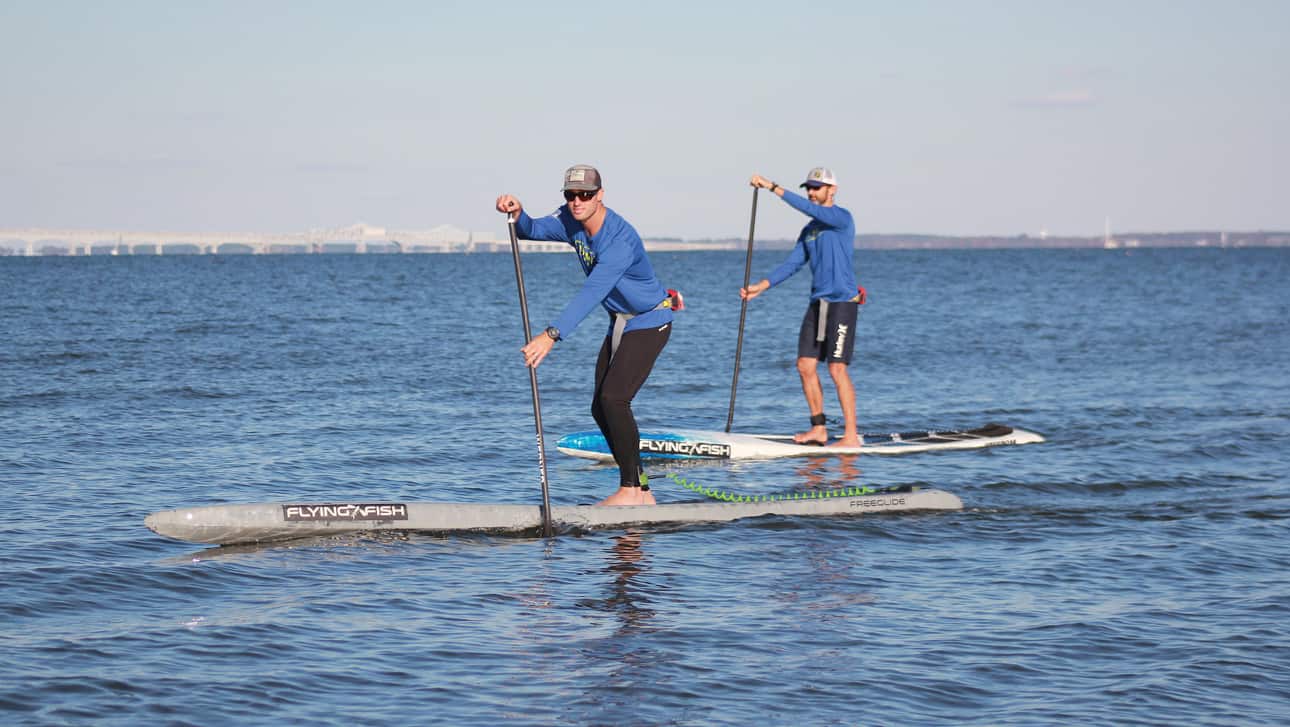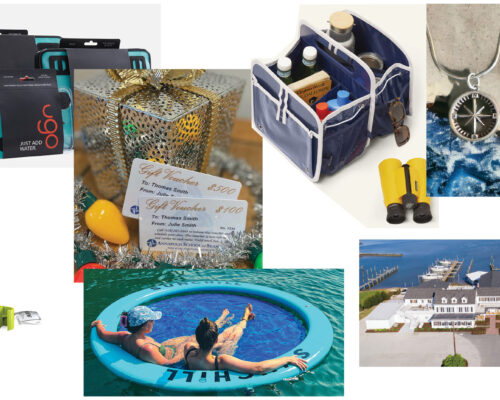The beginnings of the Annapolis Boat Show
Someone at the bar said, “Why don’t we just have them come to view the boats already in the water”? It’s not clear who suggested that prophetic idea at the Annapolis Yacht Club in the late 1960s. But that was the discussion that lead Larry Newark, a yacht broker at Arnie Gay’s Yacht Yard, and Jerry Wood, the founder of Annapolis Sailing School, to recruit Peter Carroll, the Washington Home Show producer, to manage an in-the-water boat show in Annapolis. It was a courageous idea given that the economy was about to enter a recession, which was likely to depress the boat business, again.
They chose October, one of the Bay’s most predictable good weather months, for the first show date in 1970. On the third day of the five-day show, it rained all day with no apparent effect on the attendance of roughly 62,000 sailors, a number greater than expected by the producers and the City of Annapolis, which received a cut of the gate. Fifty-one sailboats were on display in the water, and there were two tents covering marine equipment merchants. In the show’s second year, the largest sailboat for sale was a 58-foot Alden Boothbay Challenger which proved the theory that boats too large for the indoor shows would come to an in-the-water show. In that year, there were 74 sailboats at City Dock. By 1980 there were nearly 300. In 1972, the first in-the-water power boat show was introduced with similar success.
Before those first Annapolis sail and powerboat shows, the indoor boat shows in D.C. and Baltimore were the best local venues to introduce products to Bay-area customers.
These regional shows, referred to as “dealer shows”, were primarily served by local dealers while the boat builders and manufacturers concentrated their efforts on the big, ten-day National Boat Show held in New York City each January. Although most major urban areas held some sort of indoor boat show, often promoted as “outdoor sport” shows, the New York National Boat Show was the largest and most important boat show in the country for over seventy years.
Introduced in 1910 at the Grand Central Palace, the show saw its highest attendance after World War II when it opened at the New York Coliseum on Columbus Circle in the mid-fifties. In 1958, the show recorded almost 400,000 hull-kickers, previewing some 300 sail and power boats. But, like most indoor shows, the coliseum was limited to boats under 50 feet, and large sailboats with high masts were impossible to display. Eventually, some sailboat builders cut down their masts to fit inside. No one paid much attention to the cold concrete floors, sails billowed by electric fans, or cradles covered with faux fabric simulating waves, nor did anyone seem to care that the show was more than a mile from navigable water.
Despite its limitations, the original National Boat Show in New York served as the annual trade convention for the nation’s boating business. Sponsored by the National Association of Engine & Boat Manufacturers, the Show featured three trade-only days before opening to the public for seven days.
The New York Show could make or break a new model or product and notable companies bet their futures on orders and deposits collected at the show. Some Chesapeake Bay favorites first found traction in the market at the New York show, including the Bay-born one-design Comet in 1933, the Cruis-Along 26 in 1947, the Pearson Triton and the Hinckley Bermuda 40 in 1959, the Aquasport 22, and numerous Owens, Trojan and Chris-Craft powerboat models in the 1960s. Manufacturers soon learned that displaying at the New York Show was the single most important part of their marketing plan, and almost anyone of industry stature from both coasts was sure to be seen at the Show.
It was only fitting that the New York Show would be the mother of all boat shows, as Manhattan was the original business center of American yachting. At the turn of the 20th century, wealthy magnates commuted by water from ivy-covered manors to their offices in Manhattan in the super yachts of their time. Almost all of these waterborne commuters were members of the venerable New York Yacht Club on 44th Street. The club maintained a landing on the East River to dock the “business boats”, with the largest, such as Cornelius Vanderbilt’s 204-foot steamer, moored in the river. In 1907, there were eight yachts over 300 feet listed in the New York Yacht Club roster, an impressive number unequaled until today’s mega yacht phenomenon. It didn’t take long for naval architects to turn their drawing boards to pleasure boat design with such storied firms as Cox & Stevens, William Gardner, and Henry Gielow designing some of the most legendary yachts ever built. After WWII, those early architects were followed by three of America’s most influential yacht designers—Philip Rhodes, John Alden, and Olin Stephens, who opened offices near the Yacht Club. Off Park Avenue, boat builders Hacker, Elco, Chris-Craft, Century, Annapolis Yacht Yard, Cruise-Along, and Owens maintained costly showrooms. National magazines, Yachting, Motor Boating, Boating, and Rudder, which defined the culture of yachting to thousands of readers, were published from high-rise Manhattan offices. Even Annapolis’ Skipper magazine maintained a sales office in Manhattan through the sixties. Yacht brokerage Northrop & Johnson, one of the first firms to specialize in used boats, opened on Madison Avenue in the late 1940s, breaking the traditional model of broker and naval architect partnerships under the same roof. All of the national boating and engine associations had offices in New York, holding their annual meetings during boat-show week. The Yacht Architects & Brokers Association (now Yacht Brokers Association of America headquartered in Annapolis) held its annual dinner meeting at the New York Yacht Club with cocktails in the Model Room. Boat show week was a heady time in Gotham with the major players of the industry filling the city’s grand hotels, restaurants, and bars, where notable industry mergers and deals were negotiated.
The elite yachting culture of the Gilded Age was disappearing in the fifties, as boating became accessible to anyone with credit. Over the next few decades, into the eighties, almost all
of the legendary yachting businesses moved away from Manhattan. High-production fiberglass boats, liberal financing, and rising city rents did to Manhattan’s boat business what frequent recessions, government intervention and fuel crises couldn’t do.
But nothing altered the business of marketing boats more than the introduction of the in-the-water boat show, first held in Annapolis. An annual New York Boat Show still occurs at the Javits Center, and it is large and popular. But, what was once the industry’s big annual party has melted away. The old New York venue held in the windowless concrete building on Columbus Circle, with its potted ferns and suited salesmen gave way to fresh breezes and Topsiders on floating docks when Annapolis introduced its audacious concept in 1970. It was not long before every prominent waterfront center in the country hosted an in-the-water boat show, with its own industry party.
The Annapolis show set the standard and remains the model of how a good idea over drinks at the club and an amenable town can change an industry.




